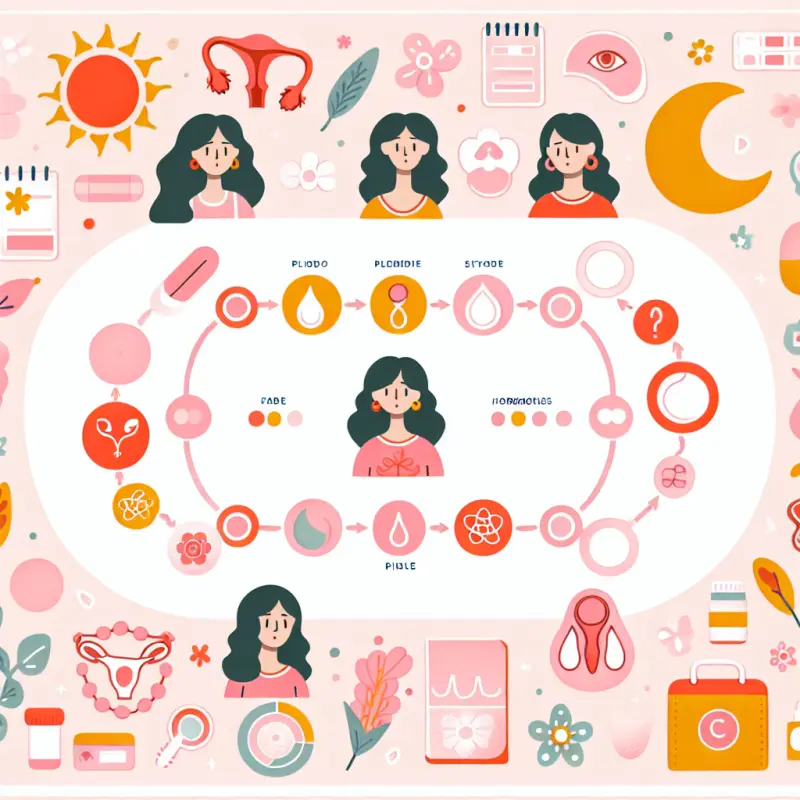The Menstrual Cycle Explained: Phases, Hormones, and What to Expect

The Menstrual Cycle Explained: Phases, Hormones, and What to Expect
Introduction
The menstrual cycle is a vital sign of health for people with periods. Understanding its phases and the hormonal changes that drive them can help you work with your body, not against it. This guide breaks down each phase, the key hormones involved, and what you can expect physically and emotionally throughout your cycle.
Table of Contents
- What Is the Menstrual Cycle?
- The Four Phases of the Menstrual Cycle
- Menstrual Phase
- Follicular Phase
- Ovulatory Phase
- Luteal Phase
- Key Hormones and Their Roles
- What to Expect in Each Phase
- Common Symptoms and How to Manage Them
- Tracking Your Cycle
- When to Seek Help
- Conclusion
1. What Is the Menstrual Cycle?
The menstrual cycle is a monthly series of changes a woman's body goes through in preparation for the possibility of pregnancy. It's regulated by a complex interplay of hormones and typically lasts between 21 and 35 days, with 28 days being the average.
The cycle is counted from the first day of one period to the first day of the next.
2. The Four Phases of the Menstrual Cycle
Menstrual Phase (Days 1–5)
- What happens: Shedding of the uterine lining (endometrium), resulting in menstrual bleeding.
- Hormones: Estrogen and progesterone are at their lowest.
- Symptoms: Fatigue, cramps, low mood, low energy.
Follicular Phase (Days 1–13)
- What happens: The pituitary gland releases follicle-stimulating hormone (FSH), prompting the ovaries to develop follicles. One follicle becomes dominant and matures an egg.
- Hormones: Estrogen rises, stimulating the growth of the uterine lining.
- Symptoms: Gradual increase in energy, improved mood, clearer skin.
Ovulatory Phase (Day 14, in a 28-day cycle)
- What happens: A surge in luteinizing hormone (LH) triggers the release of a mature egg from the ovary (ovulation).
- Hormones: LH and FSH peak; estrogen is high, progesterone starts to rise.
- Symptoms: Increased libido, cervical mucus becomes clear and stretchy, possible mild pelvic pain (mittelschmerz).
Luteal Phase (Days 15–28)
- What happens: The ruptured follicle forms the corpus luteum, which secretes progesterone to prepare the uterus for a possible pregnancy.
- Hormones: Progesterone peaks, estrogen drops then rises slightly.
- Symptoms: PMS symptoms may appear—bloating, breast tenderness, mood swings, cravings.
3. Key Hormones and Their Roles
- Estrogen: Builds the uterine lining, supports egg maturation, boosts mood and energy.
- Progesterone: Stabilizes the uterine lining, calms the nervous system, can cause bloating and sleepiness.
- FSH (Follicle-Stimulating Hormone): Stimulates follicle growth in the ovaries.
- LH (Luteinizing Hormone): Triggers ovulation.
4. What to Expect in Each Phase
- Menstrual: Low energy, need for rest, possible cramps and headaches. Focus on gentle movement, iron-rich foods, and self-care.
- Follicular: Rising energy, creativity, and motivation. Great time for new projects and socializing.
- Ovulatory: Peak energy, confidence, and libido. Communication skills are often at their best.
- Luteal: Energy may dip, mood can fluctuate. Prioritize sleep, balanced meals, and stress reduction.
5. Common Symptoms and How to Manage Them
- Cramps: Use heat, gentle exercise, and anti-inflammatory foods.
- Bloating: Stay hydrated, limit salty foods, and eat potassium-rich foods.
- Mood Swings: Practice mindfulness, get regular sleep, and consider magnesium-rich foods.
- Breast Tenderness: Wear a supportive bra, reduce caffeine, and try evening primrose oil.
6. Tracking Your Cycle
Tracking your cycle helps you anticipate symptoms, optimize your schedule, and spot irregularities. Use a journal, calendar, or a period tracking app to log:
- Period start and end dates
- Symptoms (physical and emotional)
- Flow intensity
- Any unusual changes
7. When to Seek Help
Consult a healthcare provider if you experience:
- Very heavy bleeding (soaking through pads/tampons every hour)
- Severe pain that interferes with daily life
- Cycles shorter than 21 days or longer than 35 days
- Missed periods (not due to pregnancy)
8. Conclusion
Understanding your menstrual cycle is empowering. By tuning into your body's natural rhythms, you can make informed choices about your health, nutrition, and lifestyle. Remember, every cycle is unique—what's normal for you may differ from someone else. If you have concerns, don't hesitate to reach out to a healthcare professional.
Moone — Supporting you through every phase of your cycle.